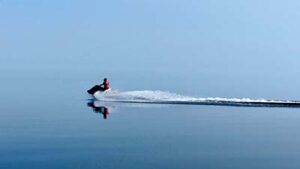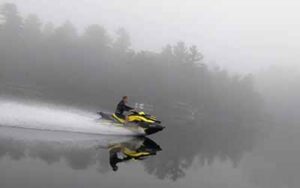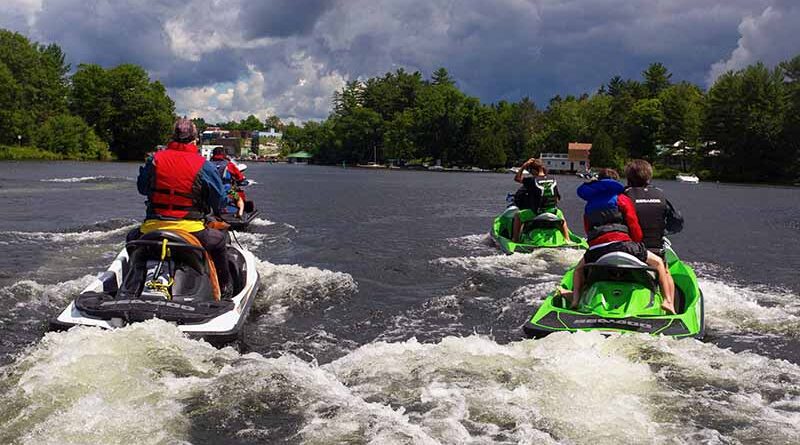Weather Tips For Summer Cruising
As every personal watercraft owner knows, the Kawarthas/Haliburton area is a recreational boater’s paradise. So every summer, thousands of residents, cottagers and visitors tour our waterways in vessels ranging from PWC’s to runabouts, pontoon boats, cruisers, houseboats and everything in between. Regardless of your choice of touring craft, venturing out of your local comfort zone on an unfamiliar waterway requires more preparation. You can cover a lot of water in a day, so many considerations become more important than usual, including the locations of launches, marinas, waterside restaurants, public docks, washrooms, locks, speed zones, and what you should carry with you, including: Pleasure Craft Operator’s Card, PFD’s for everyone on board, and the required safety/emergency equipment. I also take a “ready bag” with sun & rain protection items like sunscreen, sun glasses/goggles, riding gloves, tight cap & No Fog mask, lightweight wind stopper & waterproof jacket and water shoes, plus bottled water, granola bars, tow rope and emergency kit – and a cell phone to check the weather. 
That’s because boating may be the most weather dependent of all powersports. So knowing the latest forecast is essential, especially when today’s weather seems to be changing more topsy-turvy than ever before. In fact, on some days of touring on my PWC, I’ve increasingly encountered brief microclimates of wind, rain and even fog.
Weather can really slow you down, so your ride might take longer than expected. You don’t want to miss the last lock-thru of the day or be cruising unfamiliar waters after dark because of unforeseen weather conditions. So I usually launch early in the morning when there’s plenty of daylight ahead. Then keep a close eye on both the horizon and the actual progress I’ve been able to make on my intended route, in case I’m running late and need to change plans. For a cruise away from home base as enjoyable as possible, here are some weather-related tips I’ve learned through sometimes painful experience.
Sunny Days 
Everyone loves calm water, but the sun can beat down relentlessly. Escaping its rays on a PWC or on many other boats is impossible. You’re basically sitting in the same position much of the day. So the backs of your hands and neck get fried if you’re not careful. So do the tops of your arms, shoulders, thighs and feet. Also, the sides of your ankles, scalp and ear tips. And remember, when you’re zipping along the water enjoying a cool, refreshing breeze, you probably won’t feel the burn until it’s too late. So get the sunscreen on frequently, cover up exposed skin, and wear sunglasses!
Have You Ever Seen the Rain?
Most boaters avoid cruising in a downpour for obvious reasons. Like getting soaked, poor visibility and possible lightning strikes if it’s stormy. But riding in the rain can also be agonizing. Those drops of water smack into exposed flesh like tiny darts, pinpricks of pain intensifying the faster you go. So the first thing I do if caught in a shower is go slower. Next, I put on my rain gear, including eye and face protection, then head for shore to wait it out.
Four Strong Winds
When checking a forecast, one priority is wind speed and direction. Higher wind generates bigger waves. Big waves can slow your ride, obscure navigation buoys, markers and rocks, and be disorienting; especially if you’re on a vessel that’s lower in the water or on a larger body of water. What’s more, constantly being slammed by strong waves gives you a physical beating.
If the wind forecast is 10 kph (6.2 mph) or less, I’m good to go day tripping. If it’s edging up to 15 kph (9.3 mph), I’ll choose a more protected route like a river or lake with lots of islands and sheltered back bays and be careful not to get windblown off course when locking or docking. Anything more than 15 kph, and I’ll postpone the ride or go elsewhere if at all possible. Watch out, because a strong wind can also be the precursor of a fast-moving storm system. And you don’t want to be caught out on the water in that!
My golden rule for weather watching: If the forecast shows a high probability of rain or high winds, think twice about options like re-routing, seeking shelter, laying over or postponing your ride. Happy cruising! 
Want to learn more? Find everything you need to know about PWC riding at intrepidcottager.com.
By Craig Nicholson




